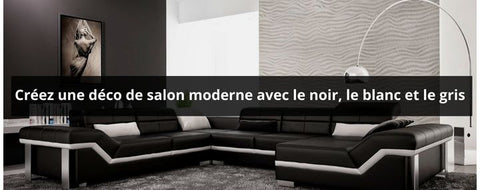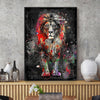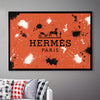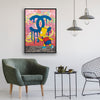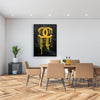
Japandi, the Decor Trend for 2020?
Have you heard about the latest trendy style in interior design? The Japanese style ! It was born from the perfect blend of two major interior design movements. Do you know which ones?
Sometimes, two styles combined are more beautiful than one alone...
If you're stuck, look no further. In this article, you'll find everything you need to know about your future favorite style! We'll also give you practical tips on how to incorporate Japandi-style decor into your home. And that includes a special selection of our most beautiful wall prints. They perfectly match this style. Take a look!
I) Japandi style: its origins?
As you may have guessed from its name, the Japandi is a hybrid of two major design movements: Scandinavian and Japanese .
The natural harmony found in Japanese style owes much to Denmark and the long-standing cultural ties between Denmark and Japan. This relationship of influence began over 150 years ago, when Danish architects, artists, and designers started traveling to Japan in search of new inspiration.
They were among the first Westerners to visit the country, which had only recently lifted its 220-year-old policy of closed borders. Many believe that traces of this early Japanese influence can be seen in contemporary Danish ceramics, furniture, open architecture, and minimalism . And the admiration is mutual, as Danish design has been sought after throughout Japan for many decades.

There is also the shared respect of nations for artisans, know-how, and natural materials, primarily wood. While the Japanese philosophy of "wabi-sabi" and the Danish philosophy of "hygiene" are both based on a deep appreciation of simplicity.
Although these movements developed in countries on opposite sides of the world, they have a lot in common. It seems perfectly natural, in fact, that someone would think of combining them! The Japandi style was conceived in 2017, but it wasn't until 2020 that it truly took off. Today, it's a genuine trend: the Japandi trend .
To understand Japandi, let's first examine each stylistic movement separately.
A) Scandinavian style: source of Japanese decor
Scandinavia cultivated its unique approach to design in the 1950s. After the world wars, there was a growing need for tasteful furniture that even average households could afford. With technological advancements, the appeal of outdoor living also increased.
In response to this, Scandinavian interiors have brought nature indoors. This is why they feature beautiful hardwood floors, plenty of natural light, and other natural materials like leather. Overall, Scandinavian interiors are calm, neutral, functional, and easy to live in. Sounds good to us...

We are fascinated by the fact that such a sparsely populated group of countries has had such a global impact. How did the rest of the world react, you might ask?
Well, in 1954, a woman named Elizabeth Gorden organized a traveling exhibition called "Design in Scandinavia." She took the best designs and had them tour the United States and Canada. Upon its return in 1957, Scandinavian design was acclaimed by international critics!
Since then, Scandinavian design has experienced ups and downs in popularity. But with a growing interest in sustainability and ethical interior design choices, this movement has greatly influenced Japanese furniture . It seems that Scandinavian interior design is here to stay.
B) Japanese style: the birthplace of Japanese decor
Japanese interior design has followed the same guidelines for centuries. It is timeless, elegant, and instantly recognizable.
Many features of Japanese homes reflect Zen philosophy . Although Zen originated within Buddhism, its core teachings have been absorbed into everyday life in Japan. Generally, it teaches us to embrace simplicity as a path to enlightenment. This concept is beautifully reflected in Japanese interior design.

So, what exactly does Japanese style look like? Here are a few characteristics to refresh your memory:
- Respect nature by using natural materials such as dyed wood.
- No over-decoration , which means using only the necessary furniture.
- Multi-functional spaces transformed by the relocation of furniture, such as screens.
In each of these features, you can see the influence of Zen. The interior space is designed to be a peaceful and calming place.
II) What are the characteristics of Japandi interiors?
Where do these major design movements meet? Here are the main characteristics of Japandi interiors. Try them at home! (Japandi living room, Japandi kitchen, or even Japandi bedroom).

A) Spaces are governed by their function
There's no superfluous decoration here! Japanese and Scandinavian interiors believe that each room should have its own unique function. Naturally, this concept is integral to the Japanese style. Every object, whether practical or decorative, must have a clear purpose.
So, get rid of those strange little ornaments you've collected over the years. If they don't serve a purpose, you're better off without them!
B) Each influence results in a different approach to color
Nordic design favors neutral tones and natural wood. Japanese design is enriched by incorporating stained woods and accents of black and red. The Japandi style brings them together. This blend of influences creates something unique! Try pairing neutral tones on your walls with stained wood furniture. This mix of old and new will have a striking effect!

C) Natural materials reign supreme
Although both styles use wood, they use it differently...
In Japanese interiors, wood is often stained, smoothed, and perhaps cut into a wavy pattern. In contrast, Scandinavian-influenced interiors take a more rustic approach. They may leave the wood unfinished, allowing the natural marble to shine through!
Choose furniture from both styles and put them together. It might take a little tweaking to get the perfect balance, but it's definitely worth it!
D) Decorative objects are always practical
The decor chosen for each style may seem different, but they are both motivated by a specific purpose. In Scandinavian interiors, accent pieces also tend to add comfort.
Think cozy blankets and warm rugs. In Japanese interiors, accents tend to be vases, paintings and screens, objects with practical or decorative uses.
In a Japandi-inspired room , blend both styles, but be careful not to overcrowd the space. Of course, don't miss this opportunity to decorate your walls. A large, empty, white space is the worst thing for ruining the Japandi atmosphere. Let yourself be captivated by our Japandi-inspired collection.

III) Which wall prints would best suit the Japandi style?
In conclusion, here is a selection of Lofty Trend wall decorations which, in our opinion, would be a perfect fit for a Japandi interior.
Notice how these pieces strike a perfect balance between decoration and negative space. They also feature rich, neutral colors together. Furthermore, each of the patterns is timeless. That's what Japandi means to us!
See you soon.
The Lofty Trend Team.





